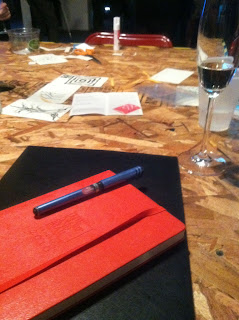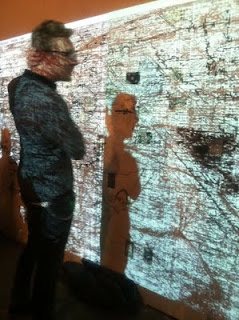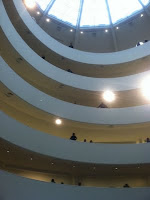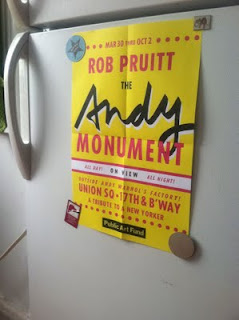 Showing the world my art was a strange experience.
Showing the world my art was a strange experience.
By “art” I don’t mean my writing, which anyone can see online (or in print, if you happened to subscribe to various music zines in the 1990s), or (some 0f) my photography, which can also be seen in various online spots. No, I mean my painting.
Painting was an obsession for me in the early aughties. It was the “last” art I discovered and sought instruction in. It was, to
borrow a phrase from Bukowski, my last creative whore – all the others were gone. Used up, dried out, buried under the weight of too many experiences and expectations too soon. “Why not drawing?” I thought. Why not, indeed.
My teacher was an experienced professional artist and instructor who encouraged curiosity and connection -with our fellow budding artists, with visual art of the past and the present, and with our chosen media. After a few weeks of basics in pencil drawing, she slowly introduced the 123s of watercolor.
“Have you painted before?” she asked me during one session, cocking an eyebrow at a snow-covered branch I was working on.
“No… why?”
Beat. A pause.
“Really?”
“Never?”
“No.”
Another pause.
“You really look like you have. This… this seems to come quite naturally to you.”
It was mere months before I’d shrugged off the watery coil of watercolor and moved on to the rich gooey sea of oils. I loved the sludge-like quality, the caramel richness of colors, the bumpy-buttery ripples and waves of texture. I even loved the sharp, acidic smell.
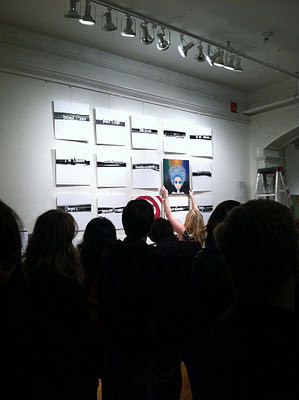
Many years and many canvases later, writing came calling again, as it inevitably would. Drawing came and went, as my visual side found expression in other things – a rediscovery of photography that ran parallel to technological advacenemtns in digital technology, experiments with black sharpies, trying out color conte for the first time. Drawing and painting had a surprisingly joyous union during a particularly experimental period last autumn, which, I have no doubt, planted the idea of my moving to New York City. Something about trying certain media together, at once, in totally new ways, blasted open neural pathways I hadn’t known existed.
And so it was, returning to purely painting. Chris Pemberton, co-founder of the Toronto live painting event
Art Battle, invited me to be a part of the
Signals From The DEW Line, an event honoring Canadian thinker and author Marshall McLuhan. Held at the storied
Gladstone Hotel, the event was a blend of poetry and painting that took as its theme McLuhan’s idea that “art, at its most significant, is a distant early warning (or D.E.W.) system that can always be relied on to tell the old culture what is beginning to happen.” Artists, then, are signifiers of change in society, of new ways of thinking and expressing and being. Heady stuff.
I didn’t think of any of this when the 18-inch square canvas was given to me. But there was something awfully stimulating about painting with a purpose. It wasn’t just some mamby-pamby thing I was doing anymore. I had a due date. I had a deadline. I had a place in the 25-painterly grid. And so, I set about, letting equal parts instinct and experience guide me, as
Soundcheck blared in the background and the taste of strong coffee sat on the tongue. A squirt of paint here, a brush stroke there; it all came together, and the piece was still tacky when I carefully walked it through the doors of the Gladstone Hotel lastnight. Suddenly this little canvas was more than just homework: it was my child.
My work has never, ever been exhibited before, not individually, and certainly not amongst the work of other, more accomplished and experienced artists. Once my piece was up, there was a momentary sense of “Oh-Gawd, mine’s-crap”-like comparison, but it didn’t last. This private act I engage in, of drawing and painting, of going past words (my admitted comfort zone and obvious stock in trade) was being scrutinized, observed, judged and enjoyed. It was like seeing a little one in their first school concert; some kids look more turned-out and comfortable than others, there’s a lot of waving and smiling, you wonder if they’ll get through it intact. When the whole class is up there taking a bow at the end, you can’t help but feel proud -of not only them, but of everyone’s else’s kid, and the fact your kids all worked together. It fortifies your sense of faith in humanity.


And that’s just how it felt, to look at my painting, hanging there with 24 other, entirely-other works. As Christopher observed, “Yours is so very different.” Of course my kid is different, I wanted to say. I didn’t plan it that way, but I’m not surprised that’s how s/he turned out. It’s nice to be with a crowd, but not of it. Even so, different-ness doesn’t guarantee confidence. Leaving my painting at the Gladstone was strange, and a bit stressful (it’s exhibited there with the others through Monday). I had a momentary twinge of -what, grief? separation anxiety? parental sentimentality? -when I walked into my tiny studio space at home and immediately noted that particular painting’s absence. It had become a sparky little fixture amongst the larger, older stalwarts, who seemed to hover and surround it in a protective huddle. I got cold thinking of it hanging in silence and darkness all night, alone and open to the elements of unfamiliar eyeballs and sneaky urban spiders.
But my little one isn’t alone – it’s with 24 other works, all with parnets of their own. There’s something reassuring about that – about being together, distinct, joined, and individual, all at once. Sooner or later, we have to let our kids go. We never stop thinking of the days we spent in squawking, squealing, squirming color, bringing this thing to life. That energy is on our own stained hands, the back aches, the neck kinks, the multi-color sinks and the spiky smells around us. We send our kids out into the world, and get right back to making a new one, over and over.
Oh yeah: My painting is the super-dark one just above the man-opens-curtain-sees-kitty work. It didn’t photograph well -at all.
My kid’s difficult that way. Sigh.
 Showing the world my art was a strange experience.
Showing the world my art was a strange experience. Many years and many canvases later, writing came calling again, as it inevitably would. Drawing came and went, as my visual side found expression in other things – a rediscovery of photography that ran parallel to technological advacenemtns in digital technology, experiments with black sharpies, trying out color conte for the first time. Drawing and painting had a surprisingly joyous union during a particularly experimental period last autumn, which, I have no doubt, planted the idea of my moving to New York City. Something about trying certain media together, at once, in totally new ways, blasted open neural pathways I hadn’t known existed.
Many years and many canvases later, writing came calling again, as it inevitably would. Drawing came and went, as my visual side found expression in other things – a rediscovery of photography that ran parallel to technological advacenemtns in digital technology, experiments with black sharpies, trying out color conte for the first time. Drawing and painting had a surprisingly joyous union during a particularly experimental period last autumn, which, I have no doubt, planted the idea of my moving to New York City. Something about trying certain media together, at once, in totally new ways, blasted open neural pathways I hadn’t known existed.


